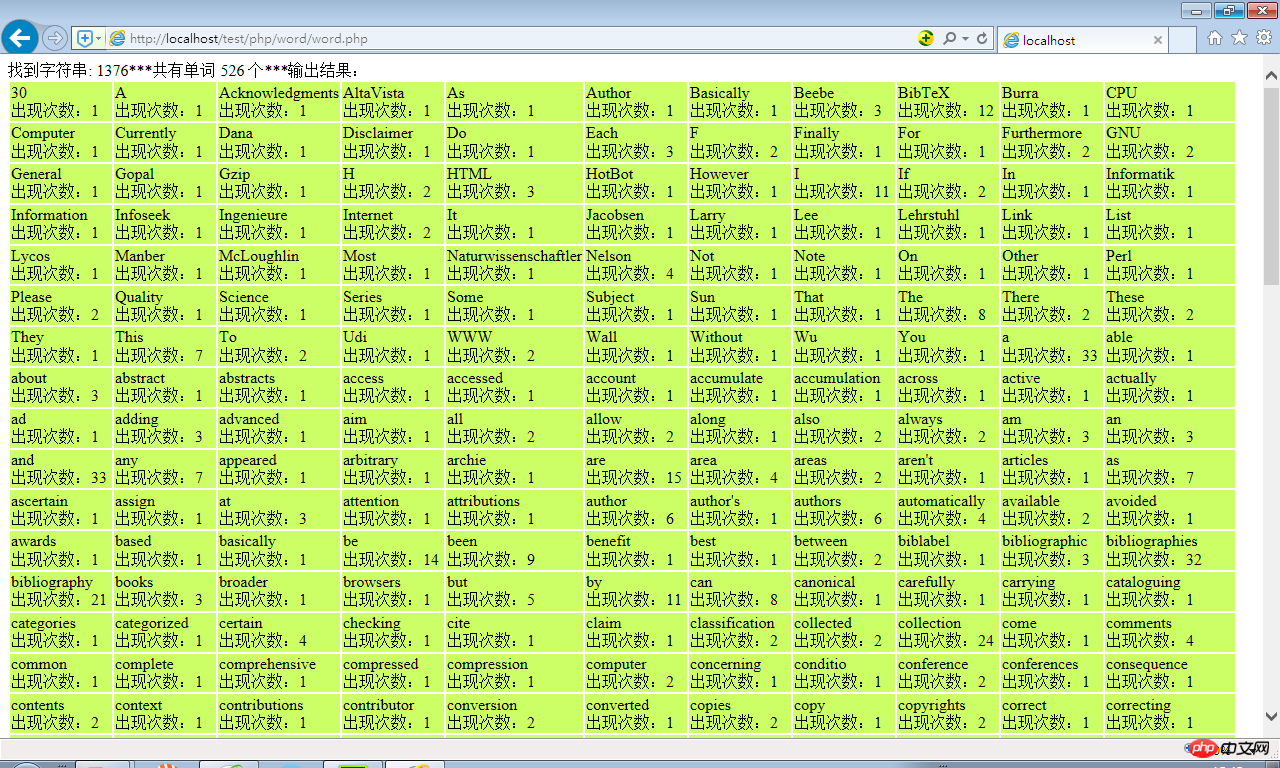
php如何实现单词统计功能?本文主要为大家详细介绍了php英文单词统计器的实现代码,希望对大家有所帮助。
具体内容如下
程序开始运行, 按"浏览"钮选择一个英文文档, 再按"统计 Statistics"钮, 即可得到按字母顺序列出的所有单词,及其出现的次数
用于测试的数据文档: data.txt
驱动程序:word.php
output.php 和 StringTokenizer.php 是 要求在同一个文件夹中的程序
1. words_statistics_PHP.png

2. word.php
<html>
<style>
td{
background-color:#CF6;
width:100px;
margin:5px;
}
</style>
<body>
<?php
/**
* 程序开始运行, 按"浏览"钮选择一个英文文档, 再按"统计"钮,
* 即可得到按字母顺序列出的所有单词,及其出现的次数
*
* 作者: 许同春 author Tongchun Xu
* @开源中国 Open Source, Chna communiity
* 完成日期:2016年6月10日 completion date: 10 June, 2016
*/
require("StringTokenizer.php");
require("output.php");
if($_POST['submit']){
if ($_FILES["file"]["error"] > 0)
echo "Error: " . $_FILES["file"]["error"] . "<br />";
else {
$myfile = fopen($_FILES["file"]["tmp_name"], "r") or die("Unable to open file!");
$str = fread($myfile,filesize($_FILES["file"]["tmp_name"]));
$delim = "?\\,. /:!\"()\t\n\r\f%";
$st = new StringTokenizer($str, $delim);
echo '找到字符串: '.$st->countTokens();
$list=new LinkedList();
while ($st->hasMoreTokens()) {
$list->orderInsert($st->nextToken());
}
$list->words_count();
$list->traversal();
fclose($myfile);
}
}
?>
<h2>英文文档单词统计 Statistics on English words </h2>
<p>程序开始运行, 按"浏览"钮选择一个英文文档, 再按"统计 Statistics"钮,
即可得到按字母顺序列出的所有单词,及其出现的次数 </p>
<form action="word.php" method="post"
enctype="multipart/form-data">
<label for="file">英文文档名 File Name:</label>
<input type="file" name="file" id="file" />
<input type="submit" name="submit" value="统计 Statistics" />
</form>
</body>
</html>3. output.php
<meta charset="utf-8" />
<?
/**
* The class LinkedList allows an application to store strings in
* alphabetical order by calling orderInsert().
* 此处定义的 LinkedList 类,可以调用它的 方法 orderInsert(),来以字母
* 大小的顺序储存 英文字符串。
* 同时记录 英文单词出现的次数
* 作者: 许同春 author Tongchun Xu
* @开源中国 Open Source, China communiity
* 完成日期:2016年6月10日 completion date: 10 June, 2016
*/
class Node{
public $data;
public $frequency;
public $next;
function __construct($data, $next = null, $frequency = 1){
$this->data = $data; //英文字符串
$this->next = $next; //指向后继结点的指针
$this->frequency=$frequency; //英文字符串出现的次数
}
}
class LinkedList{
private $head; //单链表的头结点,不存储数据
function __construct(){//单链表的构造方法
//头结点的数据为"傀儡", 不代表 任何数据
$this->head = new Node("dummy 傀儡");
$this->first = null;
}
function isEmpty(){
return ($this->head->next == null);
}
/* orderInsert($data) 方法,
* 按给定字符串 $data 的大小, 将其安插到适当的位置,
* 以保证单链表中字符串的存储,始终是有序的。
*/
function orderInsert($data){
$p = new Node($data);
if($this->isEmpty()){
$this->head->next = $p;
}
else {
$node= $this->find($data);
if(!$node){
$q = $this->head;
while($q->next != NULL && strcmp($data, $q->next->data)> 0 ){
$q = $q->next;
}
$p->next = $q->next;
$q->next = $p;
}else
$node->frequency++;
}
}
function insertLast($data){//将字符串插到单链表的尾部
$p = new Node($data);
if($this->isEmpty()){
$this->head->next = $p;
}
else{
$q = $this->head->next;
while($q->next != NULL)
$q = $q->next;
$q->next = $p;
}
}
function find($value){//查询是否有给定的字符串
$q = $this->head->next;
while($q->next != null){
if(strcmp($q->data,$value)==0){
break;
}
$q = $q->next;
}
if ($q->data == $value)
return $q;
else
return null;
}
function traversal(){//遍历单链表
if(!$this->isEmpty()){
$p=$this->head->next;
echo "输出结果:<table><tr>";
echo "<td>".$p->data."<br>出现次数:".$p->frequency."</td>";
$n=1;
while($p->next != null){
$p=$p->next;
echo "<td>".$p->data."<br>出现次数:".$p->frequency."</td>";
$n++;
if ($n%11==0) echo "</tr><tr>";
}
echo "</tr></table>";
}else
echo "链表为空!";
}
function words_count(){
if($this->isEmpty())
echo "<br>没有储存字符串 <br>";
else{
$counter=0;
$p=$this->head->next;
while($p->next != null){
$p=$p->next;
$counter++;
};
echo "***共有单词 ".$counter." 个***";
}
}}
?>4. StringTokenizer.php
<?php
/**
* The string tokenizer class allows an application to break a string into tokens.
*
* @author Azeem Michael
* @example The following is one example of the use of the tokenizer. The code:
* <code>
* <?php
* $str = "this is:@\t\n a test!";
* $delim = " !@:'\t\n\0"; // remove these chars
* $st = new StringTokenizer($str, $delim);
* echo 'Total tokens: '.$st->countTokens().'<br/>';
* while ($st->hasMoreTokens()) {
* echo $st->nextToken() . '<br/>';
* }
* prints the following output:
* Total tokens: 4
* this
* is
* a
* test
* ?>
* </code>
*/
class StringTokenizer {
/** @var string
*/
private $string;
/** @var string
*/
private $token;
/** @var string
*/
private $delim;
/**
* Constructs a string tokenizer for the specified string.
* @param string $str String to tokenize
* @param string $delim The set of delimiters (the characters that separate tokens)
* specified at creation time, default to " \n\r\t\0"
*/
public function __construct($str, $delim=" \n\r\t\0") {
$this->string = $str;
$this->delim = $delim;
$this->token = strtok($str, $delim);
}
/**
* Destructor to prevent memory leaks
*/
public function __destruct() {
unset($this);
}
/**
* Calculates the number of times that this tokenizer's nextToken method can
* be called before it generates an exception
* @return int - number of tokens
*/
public function countTokens() {
$counter = 0;
while($this->hasMoreTokens()) {
$counter++;
$this->nextToken();
}
$this->token = strtok($this->string, $this->delim);
return $counter;
}
/**
* Tests if there are more tokens available from this tokenizer's string. It
* does not move the internal pointer in any way. To move the internal pointer
* to the next element call nextToken()
* @return boolean - true if has more tokens, false otherwise
*/
public function hasMoreTokens() {
return ($this->token !== false);
}
/**
* Returns the next token from this string tokenizer and advances the internal
* pointer by one.
* @return string - next element in the tokenized string
*/
public function nextToken() {
$hold = $this->token; //hold current pointer value
$this->token = strtok($this->delim); //increment pointer
return $hold; //return current pointer value
}
}
?>相关推荐:
Das obige ist der detaillierte Inhalt vonPHP implementiert die Wortstatistikfunktion. Für weitere Informationen folgen Sie bitte anderen verwandten Artikeln auf der PHP chinesischen Website!
 statistische Analyse
statistische Analyse
 So öffnen Sie eine PHP-Datei
So öffnen Sie eine PHP-Datei
 So entfernen Sie die ersten paar Elemente eines Arrays in PHP
So entfernen Sie die ersten paar Elemente eines Arrays in PHP
 Was tun, wenn die PHP-Deserialisierung fehlschlägt?
Was tun, wenn die PHP-Deserialisierung fehlschlägt?
 So verbinden Sie PHP mit der MSSQL-Datenbank
So verbinden Sie PHP mit der MSSQL-Datenbank
 So verbinden Sie PHP mit der MSSQL-Datenbank
So verbinden Sie PHP mit der MSSQL-Datenbank
 So laden Sie HTML hoch
So laden Sie HTML hoch
 So lösen Sie verstümmelte Zeichen in PHP
So lösen Sie verstümmelte Zeichen in PHP




